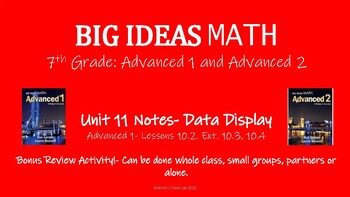Big Ideas Math 7th Grade Fill in Notes- Unit 11 Data Display
Wink's Think Lab
12 Followers
Grade Levels
6th - 8th
Subjects
Resource Type
Standards
CCSS7.SP.B.3
CCSS7.SP.B.4
Formats Included
- PDF
Pages
10 pages
Wink's Think Lab
12 Followers
Also included in
- This bundle includes a full years worth of fill in notes that aligns with the Big Ideas Math curriculum, which is designed for Minnesota State Standards. Each lesson is about 2-3 pages in length. Each new lesson page will have the lesson and standards at the top left corner of the page. These fill iPrice $40.00Original Price $46.00Save $6.00
Description
This product is designed using the Big Ideas Math Curriculum- Minnesota Edition. These are fill in notes the align with the lessons for the unit. Each lesson is either 2-3 pages. Each new lesson will have the lesson and objectives on the top left corner of the page. I usually print them off double sided and 3 hole punched so students can put them in a three hole binder. You can also print them off as one entire packet for the unit! These notes are perfect for accommodations whether it is for visual learners, SPED students, 504 students, or ELL students.
Total Pages
10 pages
Answer Key
N/A
Teaching Duration
N/A
Last updated Jul 16th, 2020
Report this resource to TPT
Reported resources will be reviewed by our team. Report this resource to let us know if this resource violates TPT’s content guidelines.
Standards
to see state-specific standards (only available in the US).
CCSS7.SP.B.3
Informally assess the degree of visual overlap of two numerical data distributions with similar variabilities, measuring the difference between the centers by expressing it as a multiple of a measure of variability. For example, the mean height of players on the basketball team is 10 cm greater than the mean height of players on the soccer team, about twice the variability (mean absolute deviation) on either team; on a dot plot, the separation between the two distributions of heights is noticeable.
CCSS7.SP.B.4
Use measures of center and measures of variability for numerical data from random samples to draw informal comparative inferences about two populations. For example, decide whether the words in a chapter of a seventh-grade science book are generally longer than the words in a chapter of a fourth-grade science book.






